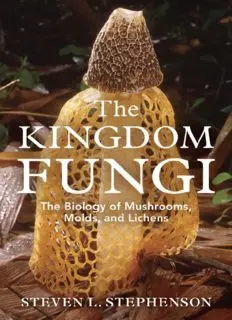
The Kingdom Fungi: The Biology of Mushrooms, Molds, and Lichens PDF
Preview The Kingdom Fungi: The Biology of Mushrooms, Molds, and Lichens
The Kingdom Fungi The Kingdom Fungi The Biology of Mushrooms, Molds, and Lichens Steven L. Stephenson Copyright © 2010 by Steven L. Stephenson. All rights reserved. Published in 2010 by Timber Press, Inc. The Haseltine Building 133 S.W. Second Avenue, Suite 450 Portland, Oregon 97204-3527 www.timberpress.com 2 The Quadrant 135 Salusbury Road London NW6 6RJ www.timberpress.co.uk Printing in China Library of Congress Cataloging-in-Publication Data Stephenson, Steven L. The kingdom fungi: the biology of mushrooms, molds, and lichens / Steven L. Stephenson. — 1st ed. p. cm. Includes bibliographical references and index. ISBN 978-0-88192-891-4 1. Fungi. 2. Fungal molecular biology. 3. Fungi—Biotechnology. I. Title. QK603.S74 2010 579.5—dc22 2009041293 A catalog record for this book is also available from the British Library. To my wife, Barbara Contents Preface Acknowledgments 1 What Are Fungi? 2 Fungi That Live in Water 3 The Most Ubiquitous of All Fungi 4 A Diversity of Form and Function 5 Morels, Truffles, Cup Fungi, and Flask Fungi 6 Mushrooms and Other Larger Fungi 7 Lichens—More Than Just Fungi 8 Slime Molds 9 The Role of Fungi in Nature 10 Interactions of Fungi and Animals 11 Fungi and Humans 12 Fossil Fungi Glossary References Index Color photographs follow pages 48 and 160. Preface This book was written to provide a basis for understanding the diversity of what to the average person is a relatively little-known and under-appreciated group of organisms—the fungi. Although it is difficult not to notice some fungi, including the molds that sometimes appear as fuzzy growths on spoiled food and the mushrooms that spring up in lawns immediately following a period of rainy weather during the summer or early fall, most people don’t know much about these widely distributed, ecologically very important, and often exceedingly common organisms. The overall purpose of the book is to introduce the reader to the biology, general structure, and morphological diversity of the “true” fungi as well as other funguslike (slime molds and water molds) and not-just-fungi (that is, lichens) organisms traditionally considered by the scientists (mycologists) who study fungi. Particular attention has been directed to examples of fungi that might be found in the home, encountered in nature, or mentioned in the media. The book should serve as a useful first text for the general naturalist, amateur mycologist, or interested layperson who simply wants to become more familiar with fungi. The book is divided into 12 chapters. The first chapter provides a general introduction to the fungi as a group. In Chapters 2–8, the major taxonomic and ecological assemblages of fungi and funguslike organisms are discussed. Chapter 9 describes various roles that fungi have in nature, including their role as mycorrhizal associates of plants and their critical function in the decomposition of dead plant material. Chapter 10 discusses the various types of interactions that occur between fungi and animals, including the ants and termites that “cultivate” certain fungi in much the same manner as farmers cultivate crops. In Chapter 11, some of the more interesting or significant ways in which fungi have been involved in human affairs are described. This includes a consideration of fungi in the literature. Fungi have been around for a long time, and Chapter 12 provides information on what is known about fungi in the fossil record, including one seemingly improbable ancient fungus that was the largest living terrestrial organism 400 million years ago. In preparing this book, I have made use of the information found in a number of textbooks on mycology. These include The Biology of Fungi (Ingold and Hudson 1993), Introductory Mycology (Alexopoulos et al. 1996), The Fifth Kingdom (Kendrick 2000), Fungal Biology (Deacon 2006), and Introduction to Fungi (Webster and Weber 2007). Additional information was derived from several field guides to the macrofungi. Among these are Mushrooms of North America (Miller 1973), The Audubon Society Field Guide to North American Mushrooms (Lincoff 1981), Mushrooms of West Virginia and the Central Appalachians (Roody 2003), and North American Mushrooms (Miller and Miller 2006). The first of these is particularly significant because it was used in my very first mycology course.
